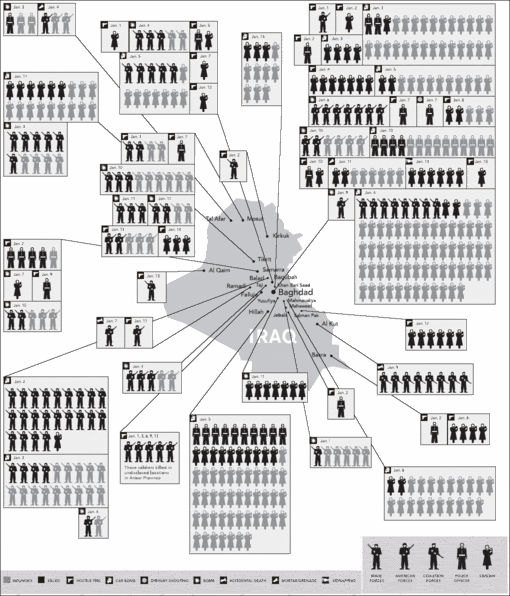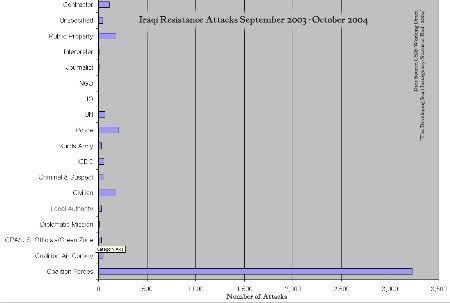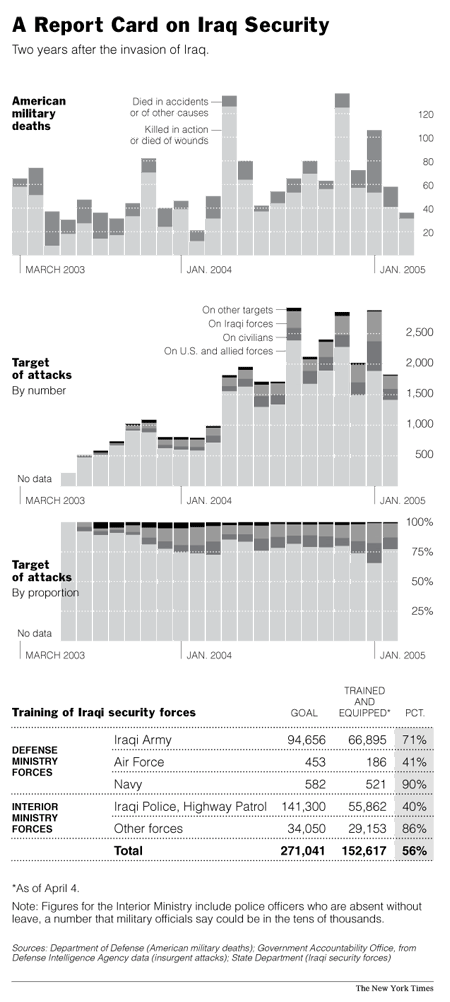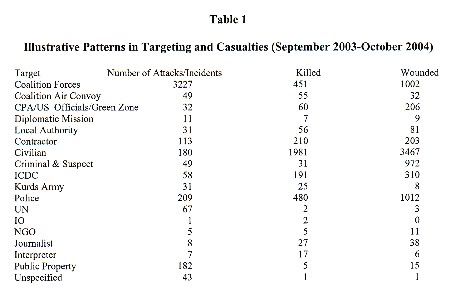Lins de Albuquerque's introduction to the chart asserts: "In the first two weeks of January, at least 202 people died as a result of the insurgency in Iraq. The killings have been indiscriminate."2 As Dave Lindorff notes, however, the chart conceals more than it reveals, as it admittedly "does not include Iraqi civilians accidentally killed by coalition forces,"3 and the US and coalition troops have been killing civilians at "a rate both higher than the rate they are being killed by insurgents and higher than the rate that the U.S. forces have been killing insurgents."4
Indeed, according to the Iraqi Ministry of Health's statistics, "operations by U.S. and multinational forces and Iraqi police are killing twice as many Iraqis -- most of them civilians -- as attacks by insurgents."5 A Lancet study published last November confirms the ministry's findings: "Violent deaths were widespread . . . and were mainly attributed to coalition forces. Most individuals reportedly killed by coalition forces were women and children."6 That is not surprising, given the sheer quantity of firepower at the US military's disposal, which even the most sophisticated guerrilla force cannot match.
While it is clear that the US and coalition forces have been killing more civilians than combatants and that more civilians have been killed by the US and coalition forces than by guerrillas, questions still remain.
First of all, do Iraqi guerrillas themselves in fact attack more civilians than combatants, as the corporate media regularly suggests?
M. Junaid Alam published an excellent article in LeftHook to answer this question: "Does the Resistance Target Civilians? According to US Intel, Not Really."7 Drawing upon Anthony H. Cordesman's report "The Developing Iraqi Insurgency: Status at End-2004"8 and "A Report Card on Iraqi Security"9 that accompanied Eric Schmitt's article "U.S. Commanders See Possible Cut in Troops in Iraq" in the New York Times,10 Alam graphically illustrates the fact that "the number of attacks on 'Coalition Forces' far exceeds that of any other category. . . . Indeed, attacks on military occupying forces, and by extension mostly US military forces, accounts for 75% of all attacks. Meanwhile, civilian targets comprise a mere 4.1% of attacks."11
The recognition that most Iraqi guerrillas seek to concentrate on attacking foreigners doing the work of colonial occupation rather than Iraqi civilians is quietly reflected in Washington's latest policy change on reconstruction of Iraq: "The administration is 'shifting work to Iraqi subcontractors that are somewhat less susceptible to insurgency attacks and are not burdened by the same heavy overhead expenses of foreign firms,' the State Department report [to Congress issued on April 6] said."12
[Click on the image above to enlarge it.]
Source: M. Junaid Alam, "Does the Resistance Target Civilians? According to US Intel, Not Really," LeftHook (16 Apr. 2005)
Source: "A Report Card on Iraqi Security," New York Times (11 Apr. 2005)
Why, then, does the Iraqi resistance, like the US and coalition forces, take a larger toll on civilians, most of whom are Iraqis, than combatants? Alam observes: "Looking at deaths and injuries in the period examined by the CSIS report, we see that 451 "Coalition Forces" were killed and 1,002 injured, whereas 1,981 civilians were killed and 3,467 injured."13
Alam's answer is that unarmed and untrained civilians are far more likely to become casualties of war than "professionally trained soldiers" protected by "sophisticated military armor";14 that, as Patrick Cockburn reports, the resistance is split "between Islamic fanatics, willing to kill anybody remotely connected with the government, and Iraqi nationalists who want to concentrate on attacking the 130,000 US troops in Iraq";15 and that the fanatics's propaganda of deeds is magnified many times by the American propaganda machine that pays "up to $US10,000 ($A13,700) a time to opportunists, criminals and chancers who passed off fiction and supposition about Zarqawi as cast-iron fact, making him out as the linchpin of just about every attack in Iraq."16
[Click on the image above to enlarge it.]
Source: Anthony H. Cordesman, "The Developing Iraqi Insurgency: Status at End-2004," Center for Strategic and International Studies (22 Dec. 2004. p. 4).
Moreover, many of the Iraqi civilians who have been killed or wounded by guerrillas were applicants seeking jobs as soldiers or policemen. Washington's practice of forcing such job applicants to wait outside concrete barriers for security reasons makes them virtual sitting ducks:
The applicants are particularly vulnerable because they are often forced to wait outside the concrete barriers set up to protect police stations from car bombs. Police officials say they generally refuse to allow job seekers freely through the perimeter because of concern that some may be suicide attackers.17To sum up, the army of occupation is responsible for by far the largest proportion of civilian casualties; both the army of occupation and armed resistance to it have killed more civilians than combatants; and a large majority of casualties are Iraqis rather than foreigners. That fits into the tragic historical pattern established by colonial occupations and anti-colonial rebellions and revolutions. To take just one example, consider the Mau Mau rebellion against the British Empire in Kenya:
The British declared the Kenya Emergency in 1952, when seven years of restless dissatisfaction with British rule culminated in the full-scale rebellion known as Mau Mau. It was very largely the struggle of the Kikuyu, the country’s majority ethnic group -- about 1.5 million in a native population of five million -- who had lost much of their land to white settlers and had moved into reservations or continued farming as tenants. The Emergency saw out two prime ministers -- Churchill and Eden -- and ended in January 1960. In that time, Mau Mau supporters killed at least 2000 African civilians and inflicted some 200 casualties on the army and police. In all, 32 white settlers died in the rebellion. For their part, the British hanged more than 1000 Kikuyu, detained at least 150,000 and, according to official figures, killed around 12,000 in combat, though the real figure, in David Anderson’s view, is ‘likely to have been more than 20,000’. In addition, Caroline Elkins claims, up to 100,000 died in the detention camps.18If the Iraqi resistance develops a political wing controlled by principled leaders capable of inculcating military discipline and enforcing the rules of war among guerrillas, fewer Iraqi civilians will die at their hands, but the fundamental casualty profile of anti-colonial insurgency is unlikely to change. Because colonizers always employ indigenous collaborators (in the roles of civilian administrators as well as soldiers and policemen) as buffers between them and anti-colonial guerrillas, more indigenous collaborators than foreign soldiers and civilians become casualties of anti-colonial insurgency. That is as inevitable as the fact that colonizers kill more indigenous civilians and combatants than anti-colonial guerrillas do. The only way to escape the dynamics of colonial and anti-colonial violence is to end colonialism itself.
Notes
1. Adriana Lins de Albuquerque and Alicia Cheng, "14 Days in Iraq," New York Times January 16, 2005.
2. Lins de Albuquerque and Cheng, January 16, 2005.
3. Lins de Albuquerque and Cheng, January 16, 2005.
4. Dave Lindorff, "What the NYT Death Chart Omitted: The Slaughter of Iraqi Civilians by US Military," CounterPunch 17 Jan. 2005 (originally published as "New York Times Iraq Death Chart Omits Biggest Slaughter: Civilian Victims of U.S. Military" in This Can't Be Happening 16 Jan. 2005).
5. Nancy A. Youssef, "More Iraqis Killed by U.S. than by Terror," Detroit Free Press 25 Sep. 2004.
6. Les Roberts, Riyadh Lafta, Richard Garfield, Jamal Khudhairi, and Gilbert Burnham, "Mortality before and after the 2003 Invasion of Iraq: Cluster Sample Survey," The Lancet 364.9448 (November 20, 2004).
7. M. Junaid Alam, "Does the Resistance Target Civilians? According to US Intel, Not Really," LeftHook 16 Apr. 2005.
8. Anthony H. Cordesman, "The Developing Iraqi Insurgency: Status at End-2004," Center for Strategic and International Studies, 22 Dec. 2004.
9. "A Report Card on Iraqi Security," New York Times 11 Apr. 2005.
10. Eric Schmitt, "U.S. Commanders See Possible Cut in Troops in Iraq," New York Times 11 Apr. 2005.
11. Alam, 16 Apr. 2005.
12. Erik Eckholm, "Rethinking Reconstruction: Grand U.S. Plan Fractures Again," New York Times 17 Apr. 2005. The State Department report mentioned by Eckholm is Bureau of Resource Management, Department of State, "Section 2207 Report on Iraq Relief and Reconstruction" (6 Apr. 2005), and the sentence quoted by him comes from the reports executive summary. Visit www.state.gov/m/rm/rls/2207/apr2005/html/ for the full text.
13 Alam, 16 Apr. 2005.
14 Alam, 16 Apr. 2005.
15. Patrick Cockburn, "Stop Killing Iraqis, Nationalists Warn Religious Fanatics," The Independent "11 Apr. 2005, qtd. in Alam, 16 Apr. 2005.
16. Adrian Blomfield, "Doubt over Zarqawi's Role as Ringleader," The Age 2 Oct. 2004, qtd. in Alam, 16 Apr. 2005.
17. Rajiv Chandrasekaran, "Police Recruits Targeted In Iraq: Bomb Kills Scores Near Headquarters," Washington Post 15 Sep. 2004: p. A1.
18. Bernard Porter, "How Did They Get Away With It?" [a review of David Anderson, Histories of the Hanged: Britain’s Dirty War in Kenya and the End of Empire; and Caroline Elkins, Britain’s Gulag: The Brutal End of Empire in Kenya], London Review of Books 27.5 (3 Mar. 2005).








3 comments:
Excellent work! A member of my blog has linked it.
good work. thanks for the information. the numbers tell it..
its amazing how the corporate media twist things
the last paragraph says it all!
Post a Comment